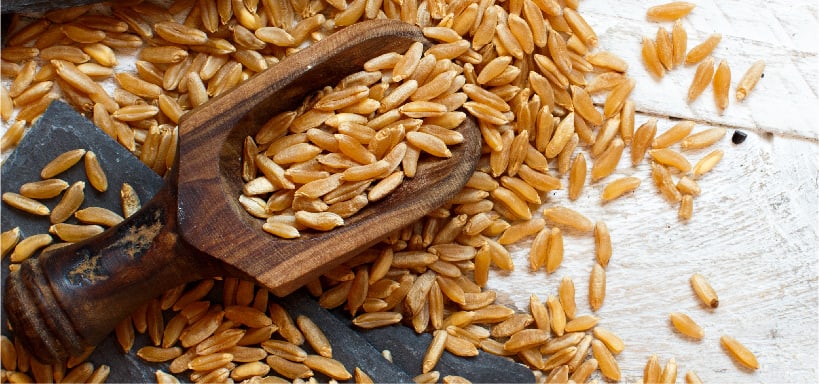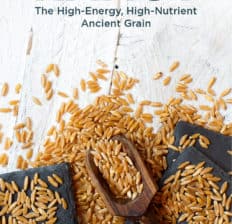This Dr. Axe content is medically reviewed or fact checked to ensure factually accurate information.
With strict editorial sourcing guidelines, we only link to academic research institutions, reputable media sites and, when research is available, medically peer-reviewed studies. Note that the numbers in parentheses (1, 2, etc.) are clickable links to these studies.
The information in our articles is NOT intended to replace a one-on-one relationship with a qualified health care professional and is not intended as medical advice.
This article is based on scientific evidence, written by experts and fact checked by our trained editorial staff. Note that the numbers in parentheses (1, 2, etc.) are clickable links to medically peer-reviewed studies.
Our team includes licensed nutritionists and dietitians, certified health education specialists, as well as certified strength and conditioning specialists, personal trainers and corrective exercise specialists. Our team aims to be not only thorough with its research, but also objective and unbiased.
The information in our articles is NOT intended to replace a one-on-one relationship with a qualified health care professional and is not intended as medical advice.
Kamut: The High-Energy, High-Nutrient Ancient Grain
April 4, 2022

Kamut® (pronounced ka-moot) is a trademarked name given to khorasan wheat. The grain had been all but forgotten, but recently it is making a comeback. This is most likely because of its enjoyable taste, texture, nutritional value and hypoallergenic properties.
Want to mix up your grain options? Add Kamut to your pantry, and use it for better digestion, brain function and energy.
Plus, it’s packed with nutrients and will keep you full for hours.
What Is Kamut?
Kamut actually has a confusing and unknown past. Scientists in the United States, Canada, Italy, Israel and Russia have all examined the grain and come to various conclusions regarding its origin and identification.
Kamut is thought to be the cousin of durum wheat, as they both belong to the Triticum turgidum family.
Kamut brand wheat has a delicious, buttery flavor. Plus, it is known to be easily digested.
Similar to bulgar wheat, it has more proteins, lipids, vitamins, minerals and amino acids than common wheat. Therefore, it serves as a more nutritious substitute.
Also, Kamut is an excellent crop for organic farming because it produces high-quality wheat without the need for artificial fertilizers or pesticides. This is because the crop has a high tolerance for diverse organic conditions, and similar to other cereals, it yields well.
The kernels are twice the size of wheat kernels and are characterized by a distinctive hump shape.
The story of Kamut’s appearance in the U.S. is an interesting one. According to anecdotal reports, the Kamut grain was found in a pyramid in Egypt, and some kernels were given to an American airman who was stationed in Portugal around 1949. The airman sent them to his father, a wheat farmer in Montana, and he planted a small amount of the grain.
He had no commercial success with it, and interest in the grain died down until Mack and Bob Quinn, father and son farmers from Montana, decided to cultivate the ancient grain in 1977. By 1990, the Quinns registered the protected, cultivated turanicum variety QK-77 as the trademark Kamut®.
Today, the wheat formerly known as khorasan wheat is called Kamut and sold in your local health food store.
Nutrition Facts
The chemical composition of Kamut wheat has a clear advantage compared to modern wheat because it contains up to 40 percent more protein. Kamut is also higher in benefit-rich zinc, magnesium and selenium, as well as many polyphenols and fatty acids.
It is known as a “high-energy grain” because of its high percentage of lipids, which provide more energy than refined carbohydrates.
One cup (approximately 172 grams) of cooked Kamut has about:
- 251 calories
- 52.4 grams carbohydrates
- 11.1 grams protein
- 1.6 grams fat
- 7 grams dietary fiber
- 2 milligrams manganese (104 percent DV)
- 304 milligrams phosphorus (30 percent DV)
- 4.7 milligrams niacin (24 percent DV)
- 96 milligrams magnesium (24 percent DV)
- 0.4 milligrams copper (21 percent DV)
- 3 milligrams zinc (20 percent DV)
- 3 milligrams iron (19 percent DV)
- 0.2 milligrams thiamin (14 percent DV)
- 0.14 milligrams vitamin B6 (7 percent DV)
- 20 micrograms folate (5 percent DV)
- 0.05 milligrams riboflavin, or vitamin B2 (3 percent DV)
- 17 milligrams calcium (2 percent DV)
Benefits
1. Supports Bone Health
The manganese in Kamut promotes strong and healthy bones. This important mineral helps reduce bone loss, especially in women who are older and more susceptible to weak bones and fractures.
Because manganese helps with the regularity of hormones and enzymes, it is also involved in bone metabolism.
Recent research shows that consuming manganese, in addition to calcium, copper and zinc, improves bone mineral density in menopausal women. and studies indicate that women with osteoporosis generally have lowers serum manganese levels than women with normal bone mineral density.
Eating foods that are high in manganese, like Kamut, which has more than 100 percent the recommended daily value in one cup, is important in maintaining strong bones and serves as a natural treatment for osteoporosis and symptoms of bone damage.
2. Aids Digestive System
Because Kamut is a high-fiber food, it aids in the regularity and function of the digestive system. Fibrous carbohydrates, such as Kamut, clean you out, fill you up and help combat bacteria and toxins as they increase the absorption of nutrients.
Research has proved that there are multiple health benefits of consuming fibrous foods, including gut motility and the prevention of digestive issues like constipation.
The level of zinc in Kamut also helps in regulating digestion. A zinc deficiency is related to chronic digestive problems and diarrheal diseases, so zinc supplementation has been shown to be effective in both prophylaxis and helping stop diarrhea.
3. Detoxes the Body
If you experience frequent headaches, bloating, gas, fatigue, muscle aches, skin problems and bad breath, then you may need to detox your liver. Kamut is an excellent source of phosphorus, an essential mineral involved in hundreds of cellular activities every single day.
Foods high in phosphorus are important for kidney function and help the body detox by eliminating toxins and waste through urine. Research shows that maintaining healthy phosphorus levels is key, so sticking to real food sources (like Kamut) instead of processed foods with phosphorus additives is ideal.
In order to balance levels of uric acid, sodium, water and fat within the body, the kidneys and other digestive organs rely on electrolytes like phosphorus, potassium and magnesium.
4. High Source of Protein
Protein makes up the structure of the cells, organs and muscles in our bodies. Kamut is a high source of protein that helps our bodies make hormones, coenzymes, blood cells and even DNA.
The great benefit of consuming high-protein foods is weight management. Protein increases satiety (or fullness) during meals, causing people to eat less overall.
If you eat just until you are satisfied, not stuffed, you only eat as much as your body needs, and this contributes to weight loss and management.
A 2015 scientific review published in the American Journal of Clinical Nutrition found that higher protein diets improved participants’ appetites, body weight management and cardiometabolic risk factors. These improvements are thought to be due, in part, to modulations in energy metabolism and energy intake.
5. Fights the Common Cold
The zinc in Kamut may help prevent the common cold and symptoms of other illnesses. Research shows that zinc can interfere with the molecular process that causes mucus and bacteria to build within the nasal passages.
Ionic zinc, based on its electrical charge, has the ability to exert an antiviral effect by attaching to receptors in nasal epithelial cells and blocking the viral infection.
A 2013 study published in the Cochrane Database of Systematic Reviews found that intake of zinc was associated with a significant reduction in the duration of the common cold. The proportion of participants who experienced cold symptoms after seven days of treatment was significantly smaller than those in the control group.
Also, the incidence of developing a cold or taking antibiotics was reduced in the participants undergoing zinc treatment.
6. Supports Brain Health
The manganese in Kamut supports cognitive health, and it helps make khorasan wheat a viable brain food.
Did you know that a percentage of the body’s manganese supply exists in the brain? Because of this, manganese is closely tied to cognitive function.
Manganese is released into the synaptic cleft of the brain and affects synaptic neurotransmission, so it is possible that a manganese deficiency can make people more prone to mental illness, mood changes, learning disabilities and even epilepsy.
A 2013 study published in the International Review of Neurobiology explains that manganese is “pivotal for normal cell function and metabolism.”
Another study published in 2003 notes that a manganese deficiency may enhance susceptibility to epileptic functions and appears to affect manganese homeostasis in the brain, which is probably followed by alteration of neural activity. (It is important to note that manganese can have a toxic effect on the brain when consumed in excessive amounts, however.)
7. Balances Hormones
Zinc and manganese are responsible for naturally balancing hormones in the body. Zinc benefits hormonal health and fertility because it plays an important role in hormone production, including increasing testosterone naturally, which has widespread roles in both men and women.
Zinc benefits female sex hormones and is even involved in the creation and release of eggs within and from the ovaries. It is needed for the production of estrogen and progesterone in women, as both support reproductive health.
When estrogen levels become too high or too low, this causes problems with menstruation, mood swings, infertility and menopause, and it might even increase the risk of cancer.
A 2010 study conducted at the Shiraz University of Medical Sciences in Iran evaluated zinc’s ability to treat sexual dysfunction in chronic renal failure patients undergoing hemodialysis.
One hundred male patients were given a zinc supplement of 250 milligrams every day for six weeks. As a result of the treatment, testosterone levels increased significantly, suggesting that zinc can improve the sexual function of patients struggling with sexual dysfunction.
8. Lowers Cholesterol
Consuming high-fiber foods like Kamut is effective for lowering cholesterol — making it a top cholesterol-lowering food — because fiber aids the digestive system and helps the body get rid of toxins and unwanted waste.
A 2013 study published in the European Journal of Clinical Nutrition compared Kamut wheat to semi-whole-grain wheat. Participants consumed products, including pasta, bread and crackers, made from one of the wheat types.
After an eight-week consumption period, laboratory analysis found that Kamut products could be effective in reducing metabolic risk factors, markers of both oxidative stress and inflammatory status.

How to Use (Plus Recipes)
You can buy a Kamut product online or at your local health food store in the grain or flour department. The wheat is used similarly to modern wheat, and it can be added to baked goods, breads, pastas, waffles and pancakes. It is even used in beer brewing.
Kamut is known for its smooth texture and its nutty and buttery flavor.
The quickest way to prepare Kamut at home is by soaking the kernels overnight. After the kernels have been soaked, add one cup of Kamut to three cups of water, and bring the mixture to a boil in a medium or large saucepan.
Once it is boiling, reduce the heat, and let it simmer for 30 to 40 minutes or until the grain is tender. If you did not soak the kernels overnight, the next best option is to simmer them for an hour.
Here are a few ways to add Kamut or a product containing the wheat to your daily diet:
- Eat Kamut grains for breakfast at home instead of oats. Add fruit, nuts and honey to create a filling breakfast bowl.
- Use Kamut pasta to make a cold pasta salad or warm and rich pasta dish.
- Add Kamut grains to a soup, stew or on top of a salad.
- Add the grains to a stir-fry.
- Use Kamut grain as a side dish, paired with grilled chicken or fish.
- Use Kamut chips or pita as a snack or side dish, and dip it in hummus.
- Use Kamut flour to make baked goods, such as cookies, cakes and muffins.
Adding home-cooked Kamut grains to a cold and refreshing salad is the perfect way to utilize its protein and fiber content. It also adds a nutty and delicious flavor to mixed vegetables.
Try adding kamut to this Taco Salad Recipe. It will keep you full and help you maintain a healthy weight.
Try swapping the quinoa out for Kamut grain in this Apple Quinoa and Kale Salad Recipe, or use equal parts Kamut and quinoa. This salad is full of fiber and essential vitamins and minerals.
If you do not have a gluten sensitivity, try using Kamut flour to make this tasty Chocolate Chip Scones Recipe. This is the perfect way to start or end a day!
Kamut grain is a perfect addition to any hearty soup or stew. This Beef Stew Recipe is healing and healthy. It’s great for your gut and full of vegetables and protein — plus, it’s easy to make!
Risks and Side Effects
Kamut wheat is safe for consumption in food amounts.
Keep in mind that Kamut does contain gluten. It is known to have less gluten than whole wheat products and to be more easily digested, but if you have a severe gluten intolerance, like celiac disease, you want to avoid consuming Kamut.
If you have never used Kamut before, start in small amounts, and see how you feel. If you start to feel nauseous or experience headaches and skin irritations, that is a sign that you may be allergic to Kamut.
If the side effects are serious, contact your health care provider.
Conclusion
- Kamut (pronounced ka-moot) is a name given to khorasan wheat, which is thought to be the cousin of durum wheat.
- It has a buttery flavor and serves as a filling fibrous food with a slew of nutrients, including B vitamins, magnesium and zinc.
- Adding Kamut to your diet can aid digestion, support bone and immune system health, promote brain function, and even lower cholesterol.
- You can buy Kamut at your local grocery or health food store. It is a versatile ingredient and can be added to breakfast bowls, salads, desserts and soups.










